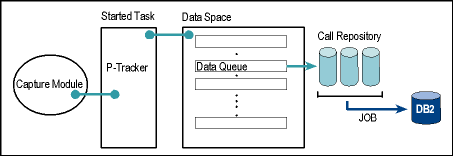|
Monitor
Program, Sub-Program, and Data Access Calls
IBM® z/OS® mainframe applications usually consist of a network of several hundred
programs which call one another dynamically or statically. They
may be preloaded by systems such as CICS® or IMS® or held in storage
as a result of compiler functions. It is therefore very difficult
to determine which program was called by which other one and from
what library it was actually loaded. This is the problem addressed
by P-Tracker. Further, for Software Asset Management the ability to understand programs being called, their location and usage is key information for management to use in ITAM and software negotiations. Another item addressed by P-Tracker.
|
|
How
it works
P-Tracker
monitors all program calls under IMS, CICS and batch with minimum performance
overhead. For each call it documents the calling program, the called module,
and the library referenced.
P-Tracker
tracks program calls by using, among other things, the SAF interface.
There it monitors all activities in the class PROGRAM. It receives the TIOT offset of the calling
program - the TIOT contains all DD names of the job - which enables positive
identification of the member and program. P-Tracker can be modified as
required by the user, for instance to control only calls referencing certain
libraries.
activities in the class PROGRAM. It receives the TIOT offset of the calling
program - the TIOT contains all DD names of the job - which enables positive
identification of the member and program. P-Tracker can be modified as
required by the user, for instance to control only calls referencing certain
libraries.
Under CICS
you normally only see that CICS has loaded a program. That point in time
may be far removed from the actual time when the program is used. P-Tracker�s
CICS interface makes the real sequence of events visible.
The P-Tracker
started task collects all its information in a dataspace and writes it
asynchronously into P-Tracker's Call Repository. A batch job removes
internal administrative data, converts fields to readable format, and
copies the user data into a sequential file. This file may be evaluated
in place or loaded into a DB2 table for further analysis using SQL queries.
The
strengths of P-Tracker:
- IMS
support
- CICS
support
- Batch
support
- Low
system overhead
- Both
module names and both libraries (caller and called) reported
-
Reliable input for repositories, inventory systems and license management
systems

Who needs P-Tracker?
Dynamic
calls, for names modified through tables, cannot be easily identified
by analyzing source code. The application programmer profits from the
complete record of call sequences held in P-Tracker. A possible repository
can be filled using P-Trackers information. Questions such as " which
program from which library uses this module? " can be reliably answered.
(Tree structure of the call sequence.)
License administration
(Software Asset Management) requires exact information on the usage of
certain software products. P-Tracker can tell you, which program was used,
how often and by whom. For mainframe z/OS usage, P-Tracker is the most trustworthy source
of this information.
A valuable
tool for inventory, asset management, data center mergers, and program
analysis.
For more information, click
Asset Discovery for z/OS P-Tracker from UBS-Hainer. The link will take you to P-Tracker ( Asset Discovery ITAM ) for z/OS which is owned and marketed by UBS-Hainer. It is the only alternative to SoftAudit © , Dorana, or TADz © that we are aware of.
-
top of page -
|
![]()
![]()